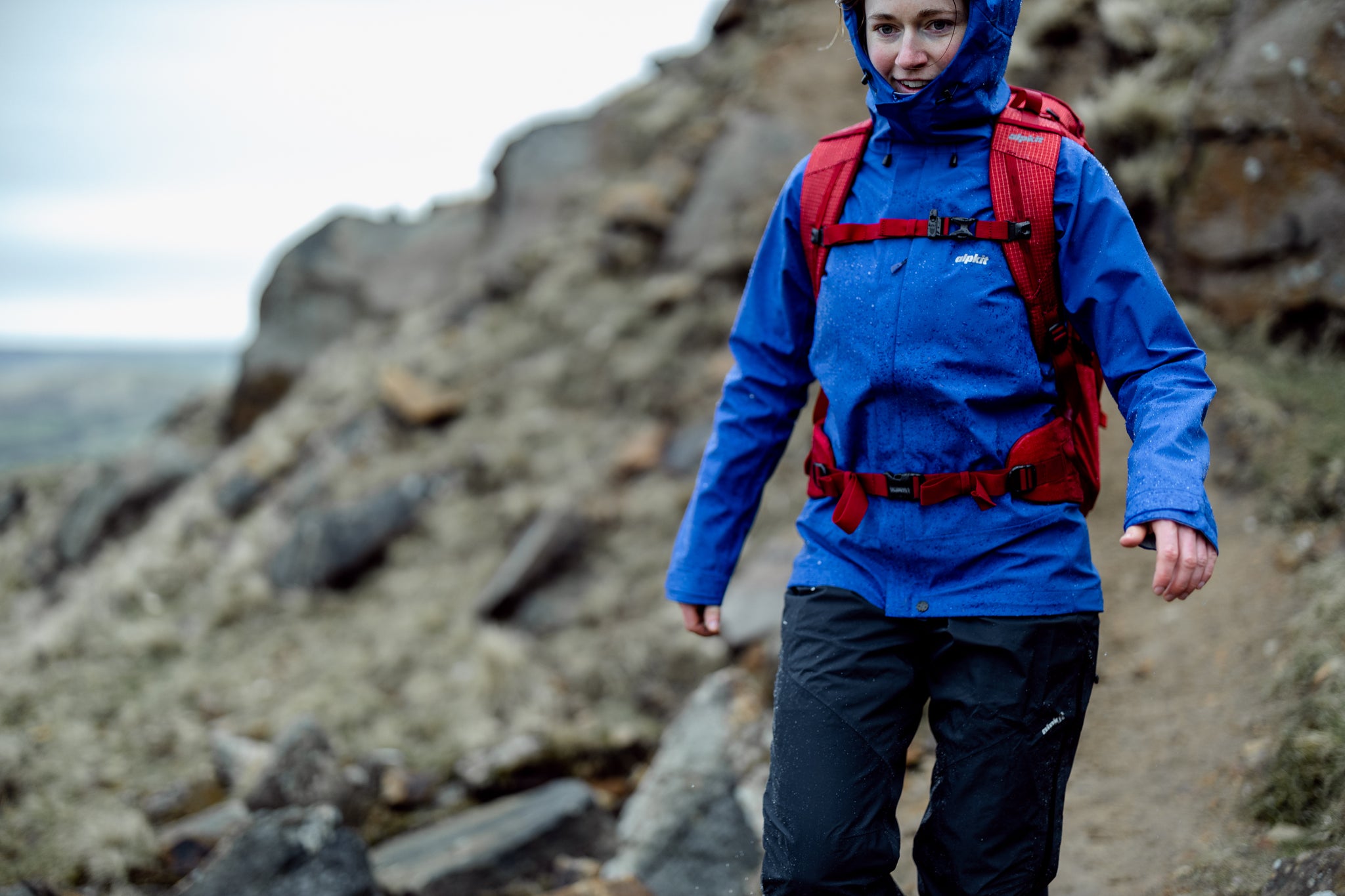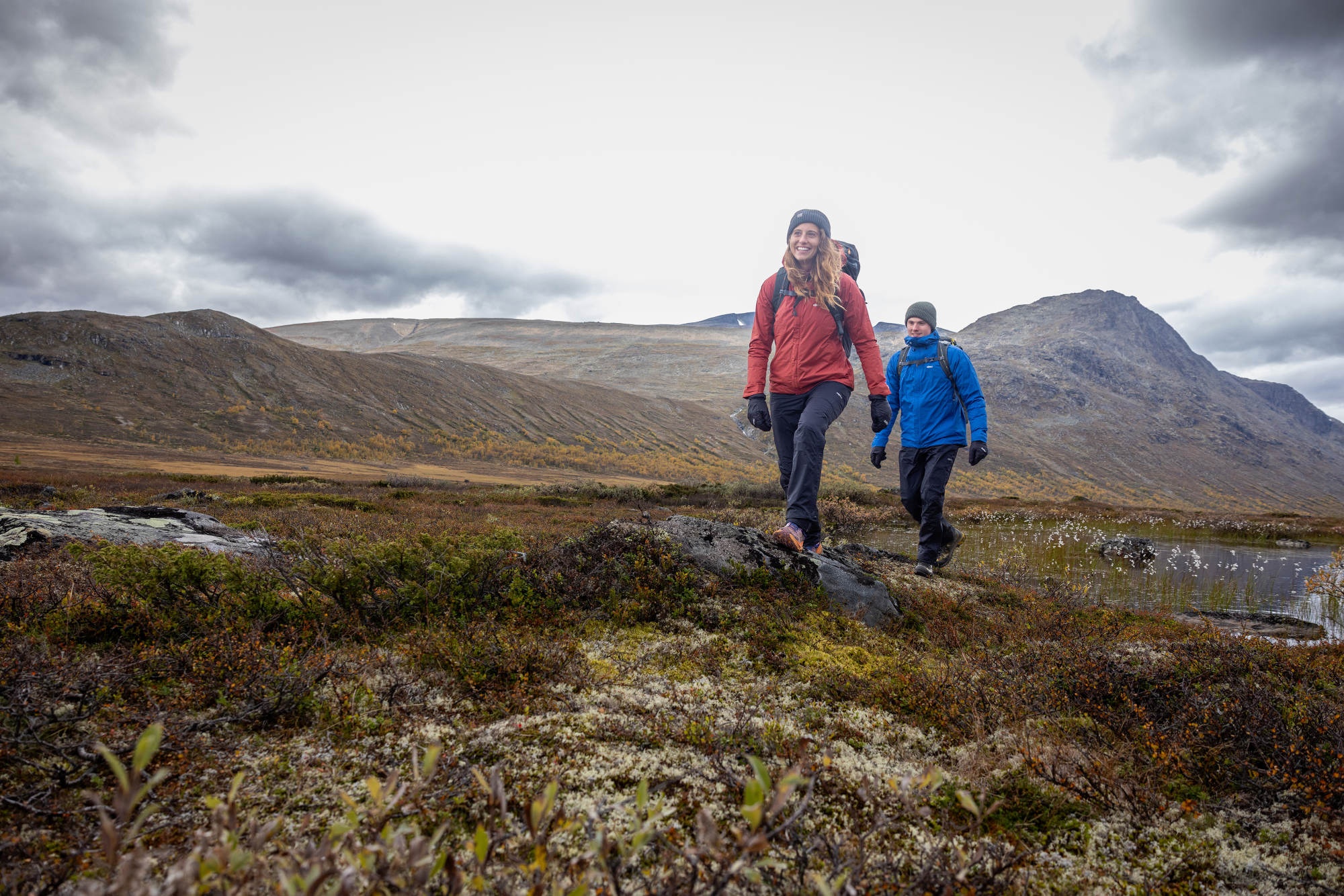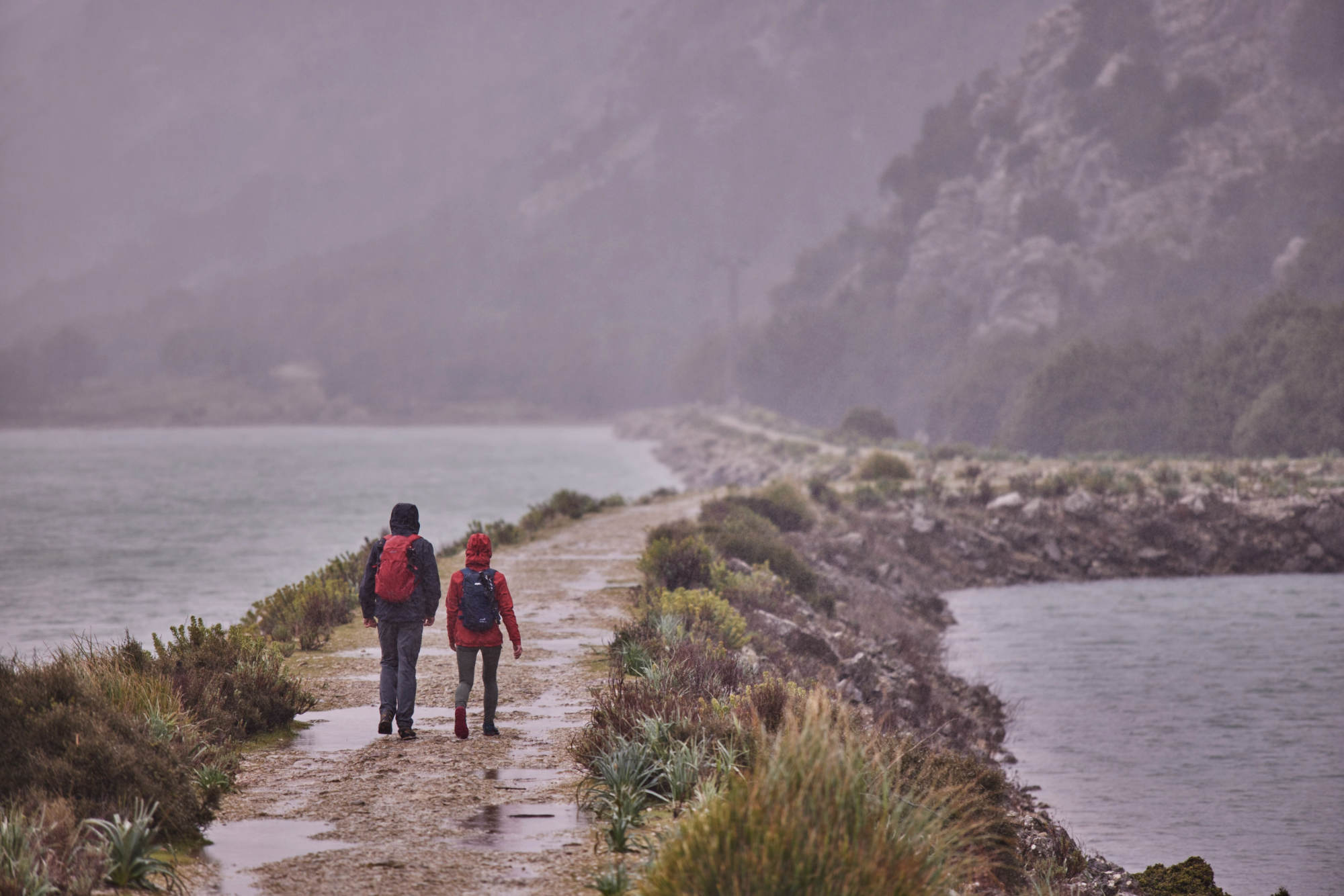
Learn how to layer effectively for your next hillwalk. Improve comfort, regulate temperature and protect against changing weather.
Layering your clothing is an important technique that lets you regulate body temperature, manage moisture, and protect against everything Mother Nature can throw at you.
The concept is to use multiple layers of clothing, each with a specific function, which can be added or removed depending on changing conditions whilst hillwalking.
The complete hillwalking solution lies in layers of clothing
Focusing on breathability as much as waterproofing, you adjust your layers, opening vents to allow moisture to escape. You experiment with different combinations of gear, discovering the effectiveness of waterproof trousers and the indispensable value of a hood that shields your face from the driving rain.
- What are the benefits of a layering system?
- How does a layering system work?
- How to layer for the outdoors
- Natural and synthetic clothing systems

What are the benefits of a layering system for hill walkers?
You want to be comfortable while hiking in the mountains. Get your clothing right, and you will increase your performance and enjoyment. In some cases, it may provide life-saving protection.
The solution, which is as valid today as it was 100 years ago, is combining several garments. We call this a layering system.
Wearing multiple thin layers makes it easier to cool yourself down, warm up and adapt to changing weather conditions. Wearing several thin layers keeps you warmer than one or two thicker layers. Don't let changes in your activity hinder your hill comfort. Stay comfortable and adapt effectively with the most useful tool at your disposal - layering.
How does a layering system work?
A top-quality layering system effectively manages moisture, regulates your temperature, and provides a barrier against the harsh weather conditions you may experience in the hills.
To function well, each layer must be made from breathable and fast-drying materials.
Wearing wicking layers (which transmit sweat away from your body) and breathable (allow moisture to pass through) means that the warm, moist air produced by your body can move through your clothing to the air outside.
The result is no more damp and clammy feelings while stomping uphill and no more shivering when you stop for a sandwich at the summit cairn.
How to layer for hill walking
The classic hill walking layering system consists of a base layer, a mid-layer and an outer layer.
Base layer: This layer sits next to your skin, it moves moisture away quickly.
- Purpose: Wicks sweat away from the body to prevent dampness which can cause a chilling effect.
- Materials: Typically made of synthetic materials like polyester or natural materials like merino wool, which have good moisture-wicking properties.
- Types: Lightweight (for mild to cool conditions), Midweight (for colder conditions), and Heavyweight (for very cold conditions).
Midlayer: Provides insulation while still allowing moisture to pass through.
- Purpose: Traps body heat to provide insulation. Its effectiveness depends on its ability to trap air.
- Materials: Common insulating materials include fleece, down, and synthetic insulations like PrimaLoft or Thinsulate.
- Types: This layer can vary greatly depending on the conditions. It could be a light fleece, a down jacket, or a heavyweight synthetic jacket.
Outer layer: Protects you from wind and rain and locks in essential warmth.
- Purpose: Shields against wind, rain, snow, and other environmental factors.
- Materials: Typically made of waterproof and breathable materials like Gore-Tex or eVent, or if you are independent like us, you get to choose your own. These materials let vapour (from sweat) out without letting water in.
- Types: Depending on the activity and conditions, this can range from lightweight wind jackets to heavy-duty waterproof shells.
Let us take a deep dive into each of these layers.

1. Base layers
Base layers need to be either wicking and fast-drying (like synthetics) or highly breathable (like merino wool) to move moisture away from your skin to the next layer. This keeps you cool in hot weather and stops you from getting damp and chilly in cold weather.
Base layers come in various materials and fabrics, and there's much debate about Merino vs synthetic base layers. You'd generally only wear a warmer base layer in winter to beef up your existing layering system. You can also wear thermal leggings in extreme cold or for lower-intensity cold weather activities.
Synthetic base layers: These are usually made from polyester but can sometimes be polypropylene or nylon (often called polyamide). Synthetic base layers are generally very fast-drying, high-wicking, light and durable.
Merino wool: Merino wool base layers are made from super fine wool fibres that are softer and faster drying than standard wool fibres. merino wool base layers are naturally breathable and odour-resistant, keep you comfortable in a broad range of conditions, and have an exceptional warmth-to-weight ratio.
Merino blend: Merino blend base layers are the best of both worlds. They have all the magic of Merino but with the added durability of synthetic fibres woven in. That means they last longer and can be much more durable at the same lighter weight than pure Merino.
Polycotton: This blend of polyester and cotton combines the fast-drying properties of polyester with the soft, natural feel of cotton. They make good base layers for valley activities like bouldering and lower-level walks.
2. Midlayer
Your mid layer is your main insulating layer, trapping still air and the heat your body generates when you move. You can easily tailor your mid-layer to the outside temperature and your own internal thermostat with so many different options. On wet, mild days, you may even go without a mid-layer altogether.
Opting for highly breathable and fast-drying materials for this layer is a good idea. This allows moisture and excess heat to pass through easily. However, you may find less breathable layers lock in more warmth. This is useful for low-intensity winter sports (like skiing) or stop-start activities in extreme cold (like winter mountaineering).
Fleece: Fleeces are the go-to mid-layer for most outdoor folk. Fleece is the perfect mid-layer material; it's incredibly light, warm for its weight, wicking, fast-drying, and phenomenally breathable. We have a range in various weights, from lightweight grid fleece to true winter weight designs. The only downside with fleece is that it offers very little wind resistance when you take off your outer layer (although some fleeces use a dense-knit outer to counteract this).
Wool: All hail the woolly jumper! Wool makes a fantastic mid layer for the same reasons it makes such an excellent base layer – it's naturally insulating, breathable and odour resistant. And, like fleece, wool loses very little of its insulating ability when wet for superior damp weather performance.
Insulated jackets: Lightweight down and synthetic jackets can be used as cold weather mid-layers if they're low profile enough to fit under your outer layer. Insulated jackets will lock in the most warmth, but they tend to use fully windproof fabrics, which can get a bit sweaty when worn underneath another windproof outer layer. Some synthetic jackets use 'active insulation', which allows them to use more breathable (but still wind-resistant) fabrics.

3. Outer layer
This layer is your defence against the elements, trapping all those lovely pockets of warmth inside. Your outer layer also needs to be breathable to allow all that body moisture to continue its journey to the outside air. Otherwise, you may as well be wearing a sweaty plastic poncho – or a bin bag!
Waterproof Jacket: Breathable waterproofs (sometimes referred to as hard shells) use a clever membrane that keeps out wind and rain, but still allows the water vapour produced by your body to pass through. They're treated with a 'durable water repellent' (DWR), which maintains breathability and stops the jacket from absorbing water, which would soon make you cold. Waterproofs are the least breathable of the outer layer options, but they're absolutely essential for keeping you warm and dry in changeable conditions.
Soft shells: These soft and stretchy outer jackets are either fully windproof of highly wind-resistant. They're generally more flexible and comfortable to wear than waterproofs and significantly more breathable (although some brands use windproof membranes that reduce breathability). They're also water resistant, using a DWR to shrug off light showers or snowfall.
Windproofs: Sometimes called windshells or windshirts, these super thin jackets are incredibly light and packable, providing instant relief from strong winds. They tend to be used for high-intensity activities like trail running and cycling.
Advanced Layering for hillwalkers
- Softshells: These are hybrids that combine some protection from the elements (like wind or light rain) with some insulation. They are more breathable than hardshell outer layers but less protective.
- Vests: They can provide additional core warmth without the bulk or restriction of full sleeves.
- Insulated Pants: For extremely cold conditions, you might use insulated pants in addition to the typical layering for the upper body.

Hybrid layers: Thanks to modern outdoor clothing technology, many layers do not fit neatly into one camp or the other. Some jackets feel more like a mid-layer and outer layer fused into one. Our Morphosis, Jura Mountain Smock, and Katabatic jackets are good examples. They're layers that can worn all day with highly breathable fabrics and insulation (grid fleece, pile fleece and PrimaLoft® Gold Active, respectively). They're much more wind-resistant than other mid-layers, allowing you to use them as your outermost layer without losing all your precious warmth.
Insulated Jackets: These jackets are designed to keep you warm when stationary or for lower-intensity activities. They usually use fully windproof outer fabrics and compressible down or synthetic insulation. This makes them great layers to pack in your rucksack for lunch stops, evening camps and long belays when you know you'll get cold.
Belay Jackets: Designed to be worn over all your layers, including your hard shell. These oversized insulated jackets were initially developed for ice climbing and mountaineering to keep you warm on long belay stops without de-layering. They're usually filled with damp-resistant synthetic insulation for UK use or down for more Alpine conditions.

Layer, De-layer, Re-layer
You might hear people say they "run hot" or "run cold." We all operate at different temperatures when we're moving outdoors. Some of us get hot quickly and cool quickly, and some are consistently cold all day! It takes trial and error with various combinations of layers before finding your favourite options and sweet spot.
And don't forget: be bold, start cold! You soon warm up once you start moving.
A multi-layered approach to hillwalking.
We have laboured over the theory, now it is time to dive into some product choices that can make this work. Our first solution is based on synthetic fibres, and the second is a modern twist on natural fibres.

Modern synthetic fibres
Prioritising ultimate performance, ease of care and versatility. For the UK's hills and summits, our performance clothing withstands the rigours of an active outdoor life, whether you're munro bagging, planning a multi-day backpacking trip, or walking around your local woods.
Baselayers
Aztec Short Sleeve top
The Aztec Short Sleeve is an ultra-lightweight merino blend tee designed for outdoor activities, providing superior temperature regulation and comfort across various weather conditions. Its 140gsm core-spun merino fabric is quick-drying, odour-resistant, and itch-free, perfect for layering and sustained performance. Ideal for eco-conscious adventurers, it uses non-mulesing Australian Merino and GRS-certified recycled polyester, ensuring durability without harming the planet. Featuring flatlock seams for added comfort under a rucksack, the Aztec is the go-to for anyone seeking a lightweight, high-quality base layer for walking in.
FKT Boxers
FKT Boxers are perfect for extended hikes. They feature a moisture-wicking, fast-drying fabric blend for comfort and support in hot weather. Because they are quick-drying, you can travel light, needing only a few pairs for extended trips. These boxers ensure chafe-free support and can be worn comfortably under your backpacks waist strap.
Midlayers
Akita top
The Akita fleece jacket is perfect for hiking up the pace in cooler conditions. Its breathable, fast-drying, and lightweight design offers warmth without slowing you down. A soft inside and wind-resistant outer provides comfort and protection as an outer layer or a sleek mid-layer for slower activities. Akita features include a full-zip for easy cooling, two zipped pockets for essentials, and a design that's comfortable under your rucksack.
Arnison walking trousers
The Arnison hiking trousers are designed for comfort with the durability needed to tackle the UK's mountain summits in all weathers. Features like a diamond gusset crotch and articulated knees promote easy movement over challenging terrains. These trousers come with practical storage, including a phone sleeve and an OS Map-sized thigh pocket. Made from tough, wind-resistant fabric treated with PFC-free DWR, they're ready for all weather conditions. Added stretch from spandex and a micro-fleece waistband enhance comfort, making the Arnison ideal for year-round walking adventures.
Shell
Fortitude waterproof
The Fortitude is our hillwalking-specific waterproof jacket designed for maximum protection. It features a longer cut and a regular fit for layering. Made from 100% recycled material, it's both waterproof and breathable, offering reliable coverage against harsh conditions. This environmentally friendly jacket includes practical features like deep pockets, an OS-map-sized chest pocket, and a fully adjustable hood. Its durable 70D polyester outer fabric is tough and sustainable, ideal for the eco-conscious hillwalker seeking comprehensive weather protection.
Cloudburst waterproof trousers
The Cloudburst waterproof trousers offer lightweight, packable 2.5-layer waterproof protection, perfect for handling wet weather on hikes. Crafted from durable, 100% recycled nylon with a PFC-free DWR coating, they're environmentally friendly and designed to shield you from the wind and rain. Features like knee-length side zips ensure easy dressing over walking boots. At the same time, an articulated design promotes movement without excess bulk. An elasticated waistband with drawcords at the waist and cuffs allows for a customisable fit, making these overtrousers a practical choice for hillwalkers wanting to stay dry and comfortable during walks.
Footwear and gaiters
Rain or shine, easy trails, or a rocky, steep ascent - you never know what is waiting around the bend. But with the right socks, boots and gaiters, you can take it all in your stride.
Breathable, waterproof walking socks are great for adding a waterproof layer to fabric boots or approach shoes. If you have a decent pair of waterproof walking boots and gaiters you will be more comfortable layering up with regular socks. Ushbar trekking socks are prized for their moisture-wicking properties and ability to keep hikers feet cool and dry.
Choose boots that are light and supportive. We recommend Vibram® outsoles; they really set the bar high for a reliable grip on wet and slippery rocks. Their tread pattern clears mud efficiently, whilst a pronounced heel delivers good grip whilst descending.
Internally, a PTFE-free, CO2 Neutral Sympatex waterproof, breathable membrane will keep your feet comfortable and dry. This poreless, compact membrane works on both physical and chemical principles to wick sweat away from the foot whilst providing waterproofing against any water ingress.
Over the top of your boots, a pair of gaiters will provide added protection from rain and mud. Our Colca hiking gaiters use a 3-layer breathable waterproof fabric to keep your legs dry without getting too sweaty. The lower sections are made from highly abrasion-resistant ballistic Cordura® to reinforce this high-wear area.
2. Natural fibres

Move naturally with clothing that combines traditional technologies with modern design. We design natural fibre alternatives for all our technical outdoor gear. They're renewable, biodegradable, less dependent on the petroleum industry and can't be beaten for sheer comfort and performance.
Merino Baselayer
Natural fibres have a 'feel' you don't get with artificial alternatives. merino wool is simply a joy to wear on the hill.
Kepler Merino short sleeve baselayer top
Kepler Short Sleeve is crafted from pure merino wool. It is a versatile base layer perfect for outdoor activities like hiking. It offers exceptional breathability, temperature regulation, and a high warmth-to-weight ratio. Its natural odour resistance makes it ideal for multi-day use. Made from soft, non-mulesed Merino with ultrafine fibres, the Kepler


![Definition [Mens]](http://eu.alpkit.com/cdn/shop/files/Definition-men-2.jpg?v=1764357328&width=768)

![Definition [Womens]](http://eu.alpkit.com/cdn/shop/files/Definition-women-3.jpg?v=1764357395&width=768)
![Balance [Mens]](http://eu.alpkit.com/cdn/shop/files/balance-mens-2025-reef.jpg?v=1765566341&width=768)
![Balance [Mens]](http://eu.alpkit.com/cdn/shop/files/Balance-mens-2.jpg?v=1765566341&width=768)
![Balance [Womens]](http://eu.alpkit.com/cdn/shop/files/balance-womens-2025-black.jpg?v=1765566432&width=768)
![Balance [Womens]](http://eu.alpkit.com/cdn/shop/files/Balance-womens-3.jpg?v=1765566432&width=768)
![Fortitude [Mens]](http://eu.alpkit.com/cdn/shop/files/fortitude-mens-2025-alder.jpg?v=1765566372&width=768)

![Fortitude [Womens]](http://eu.alpkit.com/cdn/shop/files/fortitude-womens-2025-alder.jpg?v=1764270237&width=768)









![Gravitas [Mens]](http://eu.alpkit.com/cdn/shop/files/mens-gravitas-2025-chilli.jpg?v=1765566317&width=768)
![Gravitas [Mens]](http://eu.alpkit.com/cdn/shop/files/gravitas-location-1-RETOUCH.jpg?v=1765566317&width=768)
![Gravitas [Womens]](http://eu.alpkit.com/cdn/shop/files/womens-gravitas-reef.jpg?v=1764270267&width=768)



